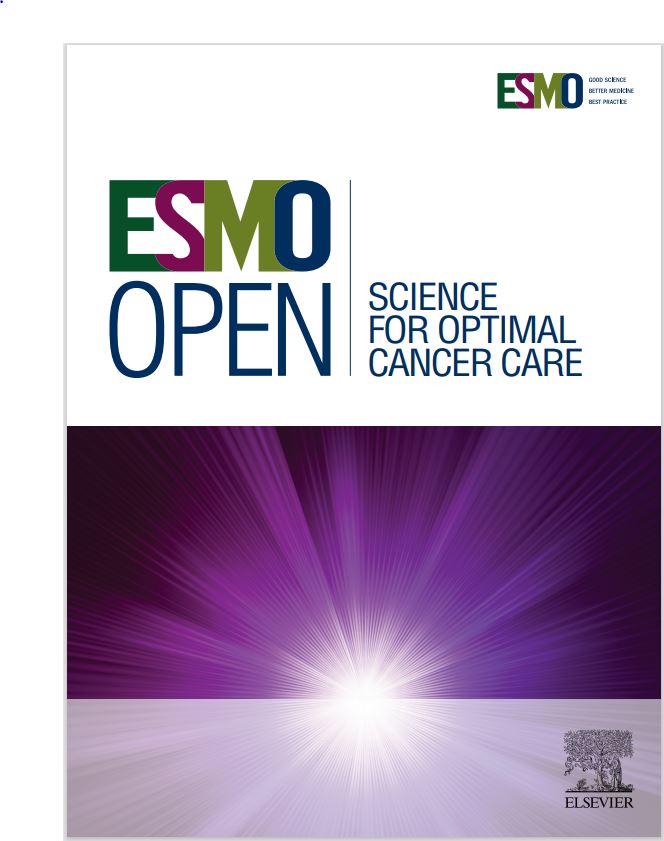Survival outcomes and the role of DNADX ctDNA testing in patients treated with sacituzumab govitecan for metastatic breast cancer☆
IF 8.3
2区 医学
Q1 ONCOLOGY
引用次数: 0
Abstract
Background
Sacituzumab govitecan (SG) is an anti-trop2 antibody–drug conjugate (ADC) approved for human epidermal growth factor receptor 2 (HER2)-negative metastatic breast cancer (MBC). However, data on effectiveness of SG and biomarkers remain limited. DNADX is a plasma-only multi-gene signature assay that identifies five tumor subtypes. In previous studies, DNADX subtypes have been associated with clinical outcomes.
Materials and methods
This study included patients with MBC treated with SG monotherapy between June 2014 and January 2023. Clinicopathological features and outcomes [time to next treatment (TTNT), overall survival (OS)] were analyzed. An exploratory analysis evaluated the association between DNADX subtypes and outcomes.
Results
A total of 121 patients with triple-negative breast cancer (TNBC), 59 with hormone receptor (HR)-positive/HER2-negative MBC, and 4 with HER2-positive MBC at the time of SG initiation were identified. Visceral disease was present in 75% of patients; 23.4% had brain metastases. Patients with TNBC had a median of 3 (range 0-9) prior lines for MBC, including chemotherapy (91%), immunotherapy (53%), and trastuzumab deruxtecan (T-DXd) (3%). Those with HR-positive/HER2-negative MBC had received a median of 5 (range 0-14) prior lines, including chemotherapy (97%), cyclin-dependent kinase 4/6 inhibitors (78%), immunotherapy (25%), and T-DXd (12%). Median TTNT was 4.3 months [95% confidence interval (CI) 3.7-5.0 months] for TNBC and 4.2 months (95% CI 2.8-4.9 months) for HR-positive/HER2-negative MBC. Median OS was 10.4 months (95% CI 8.0-13.3 months) for TNBC and 10.2 months (95% CI 7.0-12.6 months) for HR-positive/HER2-negative MBC. DNADX subtypes were significantly associated with outcomes. The tumor fraction (TF)-low subtype was linked to the longest TTNT and OS, while the proliferative and basal-related subtypes were associated with poorer outcomes.
Conclusions
Outcomes observed with SG were consistent with those reported in the registrational trials. DNADX subtypes were associated with TTNT and OS, underscoring their potential as biomarkers. Improved therapeutic options in the post-ADC setting and better biomarkers for treatment sequencing are urgently needed.
在接受sacituzumab govitecan治疗的转移性乳腺癌患者中,生存结果和DNADX ctDNA检测的作用
背景:Sacituzumab govitecan (SG)是一种抗trop2抗体-药物偶联物(ADC),被批准用于人表皮生长因子受体2 (HER2)阴性转移性乳腺癌(MBC)。然而,关于SG和生物标志物有效性的数据仍然有限。DNADX是一种仅限血浆的多基因标记检测,可识别五种肿瘤亚型。在之前的研究中,DNADX亚型与临床结果相关。材料与方法:本研究纳入2014年6月至2023年1月期间接受SG单药治疗的MBC患者。分析临床病理特征和预后[到下次治疗的时间(TTNT),总生存期(OS)]。一项探索性分析评估了DNADX亚型与预后之间的关系。结果:三阴性乳腺癌(TNBC)患者121例,激素受体(HR)阳性/ her2阴性MBC 59例,SG起始时her2阳性MBC 4例。75%的患者存在内脏疾病;23.4%有脑转移。TNBC患者既往接受MBC治疗的中位数为3条(范围0-9),包括化疗(91%)、免疫治疗(53%)和曲妥珠单抗德鲁西替康(T-DXd)(3%)。hr阳性/ her2阴性MBC患者先前接受的中位数为5(范围0-14),包括化疗(97%),周期蛋白依赖性激酶4/6抑制剂(78%),免疫治疗(25%)和T-DXd(12%)。TNBC的中位TTNT为4.3个月[95%可信区间(CI) 3.7-5.0个月],hr阳性/ her2阴性MBC为4.2个月(95% CI 2.8-4.9个月)。TNBC的中位OS为10.4个月(95% CI 8.0-13.3个月),hr阳性/ her2阴性的MBC为10.2个月(95% CI 7.0-12.6个月)。DNADX亚型与预后显著相关。肿瘤分数(TF)低亚型与最长的TTNT和OS相关,而增生性和基底相关亚型与较差的预后相关。结论:SG观察到的结果与注册试验中报道的结果一致。DNADX亚型与TTNT和OS相关,强调了它们作为生物标志物的潜力。目前迫切需要改善adc后的治疗选择和更好的生物标志物来进行治疗测序。
本文章由计算机程序翻译,如有差异,请以英文原文为准。
求助全文
约1分钟内获得全文
求助全文
来源期刊

ESMO Open
Medicine-Oncology
CiteScore
11.70
自引率
2.70%
发文量
255
审稿时长
10 weeks
期刊介绍:
ESMO Open is the online-only, open access journal of the European Society for Medical Oncology (ESMO). It is a peer-reviewed publication dedicated to sharing high-quality medical research and educational materials from various fields of oncology. The journal specifically focuses on showcasing innovative clinical and translational cancer research.
ESMO Open aims to publish a wide range of research articles covering all aspects of oncology, including experimental studies, translational research, diagnostic advancements, and therapeutic approaches. The content of the journal includes original research articles, insightful reviews, thought-provoking editorials, and correspondence. Moreover, the journal warmly welcomes the submission of phase I trials and meta-analyses. It also showcases reviews from significant ESMO conferences and meetings, as well as publishes important position statements on behalf of ESMO.
Overall, ESMO Open offers a platform for scientists, clinicians, and researchers in the field of oncology to share their valuable insights and contribute to advancing the understanding and treatment of cancer. The journal serves as a source of up-to-date information and fosters collaboration within the oncology community.
 求助内容:
求助内容: 应助结果提醒方式:
应助结果提醒方式:


